Insights into Rheumatic Diseases: Engaging the Public and Involving Patients in Research
A PER Innovation Fund project
In this blog, DPhil student Julia Salafranca talks about her two PER Innovation Fund projects and the importance of understanding rheumatic diseases. Find out more about the PER Innovation Fund here.
I am a big fan of public engagement, as I think both researchers and the public can greatly benefit from it. As researchers, we have a duty to report our results, as we are often financed by public money. But what is most important to me is that we have the power to inspire future generations and show that science is cool and accessible to all. Additionally, in medical science, collaborating with patients is key, as it can bring insightful ideas about research priorities or the feasibility of a treatment. Therefore, public engagement is an intrinsic part of my training as a scientist.
I have been fortunate enough to have been awarded two Public Engagement with Research Innovation Fund Grants by Reuben college. The aim of these projects was to raise awareness for rheumatic diseases and the research we carry out at the Kennedy Institute of Rheumatology, and to involve young people with rheumatic diseases in research.
Rheumatic diseases are an autoimmune condition, which means your immune system attacks your joints, muscles, bones and organs. Within this group, there are more than a hundred diseases, such as osteoarthritis, gout or psoriatic arthritis. They can also have other effects on the body, for example, causing cardiovascular problems or depression. My PhD focuses on researching the behaviour of a type of immune cell, called neutrophils, in rheumatic diseases. By understanding its functions and how they change in disease, we can learn how to modify them.
Although more than 350 million people in the world have arthritis, there is not much known about how the disease happens. Additionally, as it is not a lethal condition, it is not a well-funded field in medical research. The public is not aware of the difficulties that arthritis patients deal with on a day-to-day basis, due to the pain and stiffness in their joints that complicate their daily tasks, and side effects like tiredness from their medication. So, along with some other Reuben students and fellows, I co-organized the “Art & Science Day” exhibition at the Natural History Museum in Oxford during Brain Awareness and Science Week. My workshop “Painting with arthritis” was designed to raise awareness for people with rheumatic diseases, by explaining what is an autoimmune disease, how it happens, what are rheumatic diseases and how it affects the patient’s quality of life. To do so, I used the arthritis gloves (provided by NDORMS Public Engagement) that mimic the stiffness of arthritic hands and asked the participants to draw using markers with a range of different thicknesses. Participants realized that gripping fine markers and making detailed drawings with arthritic gloves is difficult. This was a great way to exemplify the difficulties arthritic patients encounter when they undertake day-to-day tasks. The workshop sparked conversations with adults about my research and why is important, while with young kids we talked about the immune system and the different cells that are part of it. Leading this event and running my workshop was a fantastic experience, as I got to enjoy a full day of fun conversations about science with people of all ages and very different backgrounds.
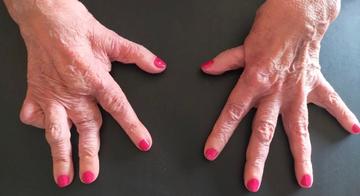
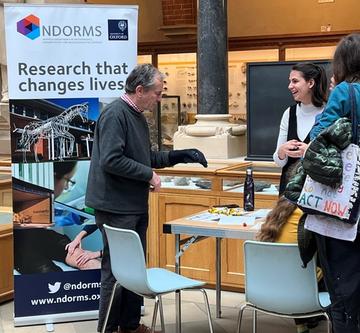
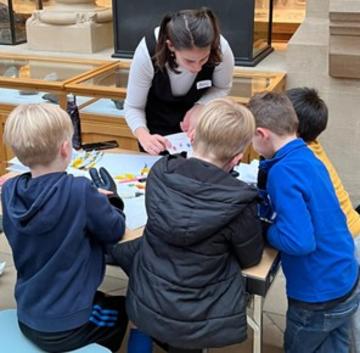
My second project aimed to involve young people with rheumatic diseases in research. Out of the many people that have arthritis, a small proportion are young adults and children. According to the charity Versus Arthritis, there were 2.8 million people under 35 in the UK with a musculoskeletal condition in 2021. However, patient involvement groups greatly misrepresent the general population, as they are mostly formed by middle-aged white women. In the UK, there is only one study that focuses on the research priorities of young people regarding rheumatic conditions.
My workshop was designed to function as a more personal group, where the discussions and activities would be preceded by a fun activity for bonding. Most patient involvement activities can be quite straightforward and impersonal, but I believe that a safe and comfortable space is needed, as people are sharing very intimate experiences. The project consisted of 3 parts: 1) an online pre-questionnaire to gather information on the age, sex, rheumatic condition and initial interest in research involvement and engagement, as well as options for the fun activity for the workshop; 2) the workshop, consisting of a fun activity as an ice-breaker and a directed discussion; 3) an online evaluation questionnaire regarding the workshop and their interest in research involvement and engagement post-workshop.
Recruiting young people with rheumatic diseases was really difficult, but with posters, the help of doctors and posting in support groups for rheumatic patients I managed to recruit 6 participants. The group was comprised of 1 male and 5 females, between the ages of 23 to 30, presenting a wide range of conditions (such as psoriatic arthritis, Sjogren’s syndrome or juvenile idiopathic arthritis). Young people with rheumatic diseases were interested in taking an active role in research, as they would like to contribute to the development of research ideas and participate in research meetings and training sessions. Most participants were also interested in reviewing grant proposals. Regarding scientific engagement, they would attend research meetings and read a newsletter on the latest research. However, participants were not interested in a laboratory or institute tour. Understanding the preferences of young patients is key to increasing their engagement with science and research involvement.
Participant's interest in engagement and involvement in research pre-workshop:
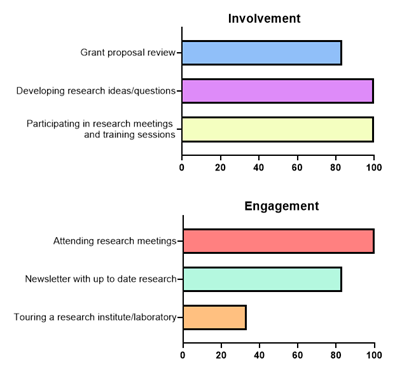
As moving is important for the health of people with rheumatic diseases and they often struggle to find time to do so, I suggested the following activities: pilates, yoga, a walk, a hike, a boardgame café, a scavenger hunt or a dancing class, which have different levels of activity required. There was a spread of answers, but the hike was the most popular answer. Nevertheless, due to the impossibility of finding a date where we could all meet in person, I decided to move the workshop to an online format. As an icebreaker, the participants, four in total, could choose between two games (drawful or quiplash). We ended up playing drawful, which consisted of drawing a word or phrase we were given and providing prompts for other players’ drawings, to then finally guess the original phrase for each drawing. All but one participant agreed this icebreaker made the discussion easier and more approachable. I think there is something special about seeing each other’s terrible drawings that bond people together.
The directed discussion was grouped into 5 themes: quality of life, support groups, involvement in research, comments for researchers and treatment course. All patients had different treatment courses, which impacted their life differently. As a researcher, I thought the main issue with a disease was the pain. However, they highlighted that their medication also caused fatigue as a side effect, took a considerable amount of time from their schedule, for example planning the hospital visits, and they suffered from pain when the treatment was wearing off or it was administered. Moreover, the disease has a big psychological impact, as they found challenging to come to terms with taking medication for the rest of their life, are used to having low-grade pain and bad or worse days, and often doubted their pain. Some of the participants had taken part in support groups but explained that these are needed especially after they turn 25. Once they pass this age, they are grouped with older people who are in a different stage of their life. This makes it hard to relate and can be even scary, as they are often in a worse condition. The participants enjoyed the setup of this workshop, as it was a small encounter where they could follow up online afterwards if they were interested.
Regarding the involvement in research, the participants had diverse opinions. They explained that the disease has a big impact on their lives, so, it is difficult to dedicate extra time to it. I already struggle enough to juggle my full-time job, social life and meal prep for the week. A chronic disease added to the mix makes it difficult to have any spare time. Therefore, they need a low-commitment activity. The participants mentioned that the fun side of this project motivated some of them to take part. Furthermore, the timing and personal journey of the patients are also key in their involvement in research, as after they are diagnosed it is a specially trying time. However, if they wanted to engage in research, they felt that these opportunities were not well advertised by rheumatologists or GPs.
As research priorities, the patients were especially interested in a more holistic approach to the treatments, and alternative approaches to medicines. They also emphasized their interest in personalized medicine, where they are seen as individuals and not just numbers or markers going up or down. I think that even though doctors and researchers are immensely grateful to the people who donate samples and their time, we have to be better at expressing this gratitude. Another area of improvement was the diagnosis delivery. Much to my surprise, some of the participants had been notified in a brief phone call or even a text message. This is probably to a lack of resources, but more empathy and time are needed to deliver the diagnosis and discuss an appropriate treatment course (both immediate and long-term) with the patients. Especially, as they mentioned, because understanding how a drug works would help them manage their expectations. However, they do not need an in-depth explanation of the biological mechanisms. These results are similar to the only study carried out in the UK to set the research priorities of young rheumatology patients, who advocated for personalized medicine and prioritized the research focusing on improving physical, psychological, social and spiritual outcomes.
After the workshop, an online evaluation questionnaire was sent to get feedback on the discussion and gather their interest in engagement and involvement in research. All participants found the discussion helped them relate to other people in their situation and provided them with a safe space to interact, while half of them are explicitly considering getting more involved in research. Specifically, all participants would like to attend workshops to interact with young researchers and people with rheumatic diseases. Other popular activities would be chatting with rheumatology researchers that had never met a patient, creating a guideline for doctors to improve patient diagnosis and treatment management, and attending short talks by scientists or doctors.
Participant's interest in engagement and involvement in research post-workshop:
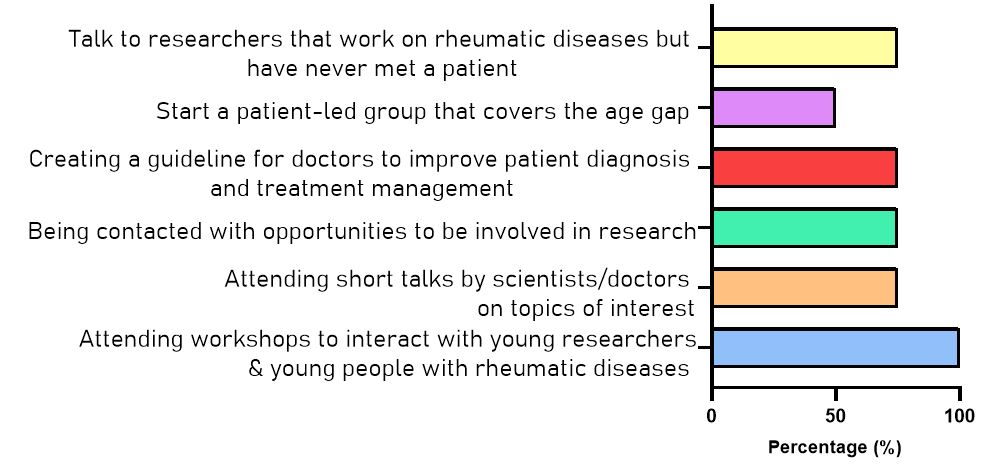
Overall, this project was a great start to the world of patient involvement. It was trying at times, especially regarding recruitment and organization, but it was rewarding to see patients enjoyed the workshop and are willing to be more involved in science. I also greatly benefited from their thoughts and experiences, which made me a better rheumatology researcher.
Julia would like to thank the participants of this workshop for their time, interest and cooperation in this project.




